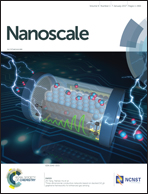Nanoconfined self-assembly on a grafted graphitic surface under electrochemical control†
Abstract
Highly oriented pyrolytic graphite (HOPG) can be covalently grafted with aryl radicals generated via the electrochemical reduction of 3,5-bis-tert-butyl-diazonium cations (3,5-TBD). The structure of the grafted layer and its stability under electrochemical conditions were assessed with electrochemical scanning tunneling microscopy (EC-STM) and cyclic voltammetry (CV). Stable within a wide (>2.5 V) electrochemical window, the grafted species can be locally removed using EC-STM-tip nanolithography. Using dibenzyl viologen as an example, we show that the generated nanocorrals of bare graphitic surface can be used to study nucleation and growth of self-assembled structures under conditions of nanoconfinement and electrochemical potential control.



 Please wait while we load your content...
Please wait while we load your content...